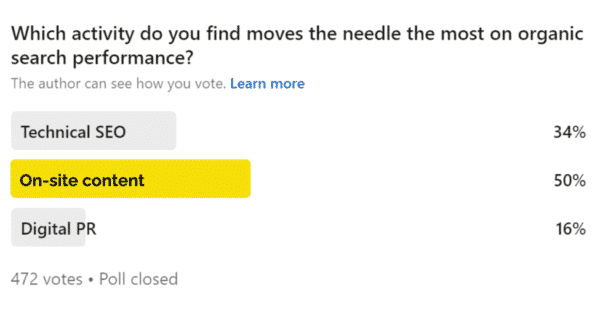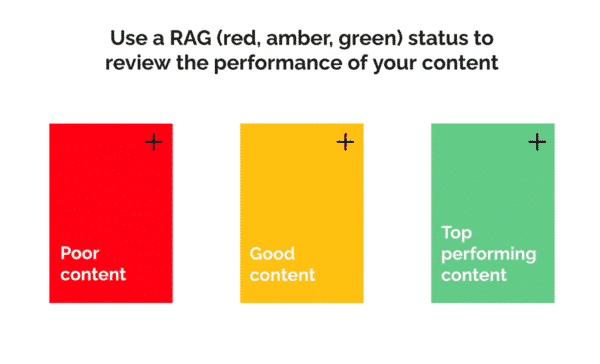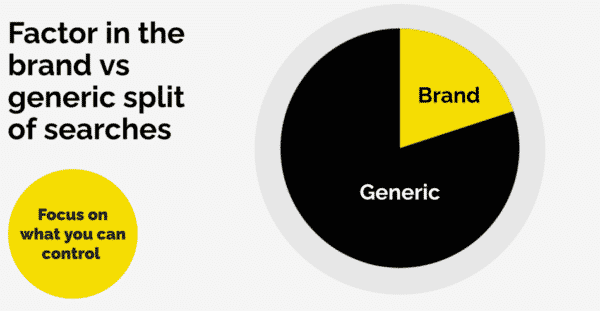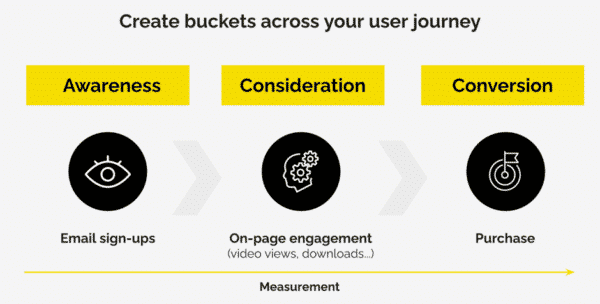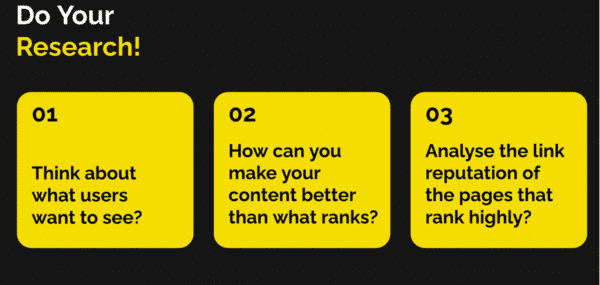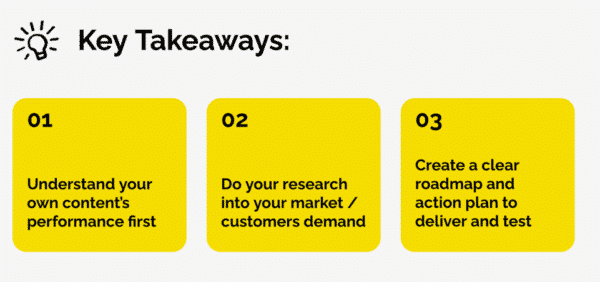How To Create an SEO Data-Driven Content Strategy
Content strategy is a hugely important part of the SEO process. Quite often it’s not given the level of attention it deserves, but done right it can be a significant driver of organic revenue and customer acquisition.
To create an SEO data-driven content strategy that works, we need to understand what good content looks like. To do that we need to look at data and conduct research. It sounds time-consuming and expensive, which might put many businesses off. But actually, you can create an SEO data-driven content strategy in just 3 steps.
Thanks to Illiya for help with the presentation slide design.
The Value of Content for SEO
When we talk about SEO, we used to work on the principle that creating content was about making it work for Google. That meant content that was littered with keywords, known as keyword stuffing, and didn’t necessarily provide any value to its readers. As long as it was on topic, it ranked.
But now it’s about creating content for people. Content needs to answer questions, provide content, be accurate, and add value. It should still have the essence of keywords, but you can’t just take a keyword and hire a copywriter on the cheap anymore. It’s all about quality – creating quality content that is accurate and adds real value. And that doesn’t come cheap, you need to invest in it.
Why Invest in Your Content
Creating content needs investment to make an impact. But when it comes to it being part of an SEO strategy, it feels like the content is under-rated and under-invested.
It seems like SEOs and marketers are aware of the value of content. If you look at our LinkedIn poll of where people see the best results from their efforts, we can see that 50% of us get the best results from content rather than technical SEO or digital PR. But this isn’t reflected when we think about where our businesses spend their marketing budgets.
We need to address this problem of under-investment in content for SEO because the benefits are endless. Even without any extra search traffic, the pay-off of additional content could be significant. Creating content can drive better user metrics, more clicks, and can also support the traffic you drive from your other marketing channels like social media and email. But if you can level up and create high-quality content that provides better information than your competitors and attract better user metrics, the benefits are even greater. Your content will be more likely to outrank your competitors in the SERPs, giving you the potential to gain additional impressions, increased clicks, and ultimately more conversions. That is without considering the benefit your content can have on your other SEO efforts, like generating backlinks.
So investing in the right quality of content should pay for itself several times over. But we still see that most of SEO spend goes on fixing technical aspects of a website (page speed, structured data, etc.) or on link acquisition and PR to improve authority and brand reputation. But why are we consistently overlooking the importance of having a strong content strategy and delivery plan?
How to Create an SEO Data-Driven Content Strategy
Creating content is easy. Creating high-quality content that is useful and works is a challenge. But it doesn’t have to be as long as you start with a strategy that follows these 3 steps:
1. Content Auditing
Before you start creating new content, you need to understand what content you have already got. Not only that but you need to understand how well it works. So start with a content audit.
First, you will need to gather all of your URLs along with how they perform in key areas. To do this you will need to:
- Export all indexed pages from Google search console
Use the coverage report with a timeframe of 12 months to account for any seasonality trends.
- Export analytics data for all of your pages
Use Google Analytics or Adobe, making sure your data includes key metrics like conversion, sales, traffic, average time on site, and bounce rate.
- Combine your two datasets into one
Use VLOOKUPs and formulas as appropriate to merge all of your metrics by URL.
Once you have the data you can use a RAG analysis model to assess its performance. This will help you to review the performance of your content by assigning a colour, red, amber, or green, to each URL based on how well it performs in terms of key metrics. In this case, we suggest that you order your data by conversion rate as this will give you the pages that are currently making you the most money.
- Sort your data by conversion rate
Make sure the highest converting URL is at the top of your data
- Colour code the URLs
With the top 33% of URLs in your data green, the bottom 33% in red, and the remaining 33% in amber
You can be more specific with this RAG analysis by pinpointing the conversion rates specific to your business that are green (good), red (poor), or amber (average). But however you choose to do this analysis, it will help you to start understanding which pages are having the most impact and where improvements can be made.
Once you have a list of URLs to improve, you can then start working on those that have the most opportunity. For example, URLs that are already ranking on page 2 will be quicker and easier to optimise to rank on page 1 and will generate much more traffic and higher CTRs for your efforts than optimising a page on page 9. So be smart with how you choose what to optimise.
2. Content Gap Analysis
When you have a clear picture of where your opportunities are with your existing content you can factor in new content. But don’t forget that churning out volume is not beneficial and effective – it’s all about the quality of your content. So you need to make sure that you are creating new content that is based on the language that your customers use to search.
Your analysis should involve 3 steps:
- Identify who your competitors are in the search landscape
You can do this using SEO tools that can give you a competitive positioning map that factors in the relevancy of a site to yours as well as the level of traffic it drives relative to yours. Doing this is important as your search competitors may not be your direct business competitors. To really understand how and what content to create, you need to know what you are up against.
You can visualise your research here in an easily-digestible graph so that you have a top-level view of who you’re competing against.
- Factor in the brand vs generic split of searches
Again, you can get a picture of what type of keywords your search competitors are ranking for using SEO tools. Doing this step is important so that you can focus on targeting keywords that are achievable and you have some level of control over them. You will likely find it easier to rank for a non-brand, generic keyword than for someone else’s brand name, for example.
- Research where the search demand is for key topics
You should try to understand where the most demand is for topics that are relevant to your industry. You can map your keyword performance against your competitors here to identify where you’re winning vs areas to improve.
Map out this performance in a way that is easy to read and gain insight from. This visualisation from the team at Re:signal is a great example.
3. Create A Roadmap
You should now have a plan for optimising existing content based on data-driven opportunities and new content ideas driven from competitor research. The next stage is filtering that information into a roadmap.
You should aim to prioritise the data you have gathered in the previous two steps here, considering:
- The value each action will drive your business
Focusing on the content that has more potential to drive conversions and therefore value to your business will ultimately be more fruitful and give you better ROI.
- Any seasonality factors that you need to consider
Creating content out-of-season has the potential to negatively affect your performance by driving the actions you don’t want. User signals are important and users won’t interact with content that isn’t relevant, so make sure you consider any seasonality or trends when it comes to planning what content to publish when.
- Stage of the user journey that your content will target
Similarly, content that doesn’t resonate with or add value to a user is much less likely to perform and drive action. So be specific with what stage of the user journey your content is designed to target, from awareness to consideration to conversion.
Then when it comes to briefing your content or sitting down to create it yourself, you need to consider more than just best practice writing for SEO. You should research each piece to gather more data on what type of content is ranking well in Google already, what users want to see, and how this differs from content you already have? Use this to identify how you can make your content better than what ranks already.
How To Measure Success
Creating content doesn’t stop once you hit publish. To make sure your content is successful at driving value to your business, you should monitor its performance and be prepared to keep investing at regular intervals.
Whether you monitor your success based on clicks, ranking, or conversions, decide on your measurement before you start, which should be based on the right metrics for the aim of your content. For example, an awareness piece of content should be monitored on micro-goals like email sign-ups, content downloads, or video views, and less about direct conversions and sales. But content targeting the consideration stage should be monitored based on user metrics like bounce rate, pages per session, and time on site.
Keep Investing in your Content
If you notice your content is not performing as you expected or stops performing, then don’t be afraid to keep investing. When it comes to content, it’s important to always keep learning, testing, and refining.
This is especially important if you have a high volume or high converting keyword that is performing well for your site. You will need to make sure you can keep it there by investing time, budget, and thought in staying current and staying useful. Your competitors are a moving target, they will be investing in creating content too, and your customer’s needs will be evolving constantly. So you will need to keep investing to stay relevant and competitive.
Summary
Creating an SEO content strategy is about creating high-quality content that performs. To do that, you need to make decisions and plans based on the data you have available, which you can gather in just 3 steps.
You will need to start by gathering data that helps you to understand your own content’s performance. Then you can research market demand, gathering data on your competitors. You can then use these data points to create a clear roadmap and action plan to deliver, which you can then continually test and learn to keep improving.
The content of these 3 simple data-driven steps can be rewarding and drive strong performance metrics. It might require investment, whether that is in time or money, but content is important and massively beneficial. It should be taken at least equally as seriously as technical SEO and link reputation, if not more so. Make content your king! Invest in producing the right content in the right place at the right time.
Further Reading
For case studies and more information about putting your SEO strategy into practice, listen to our CEO, Kevin Gibbons, talk at Ungagged search conference.



